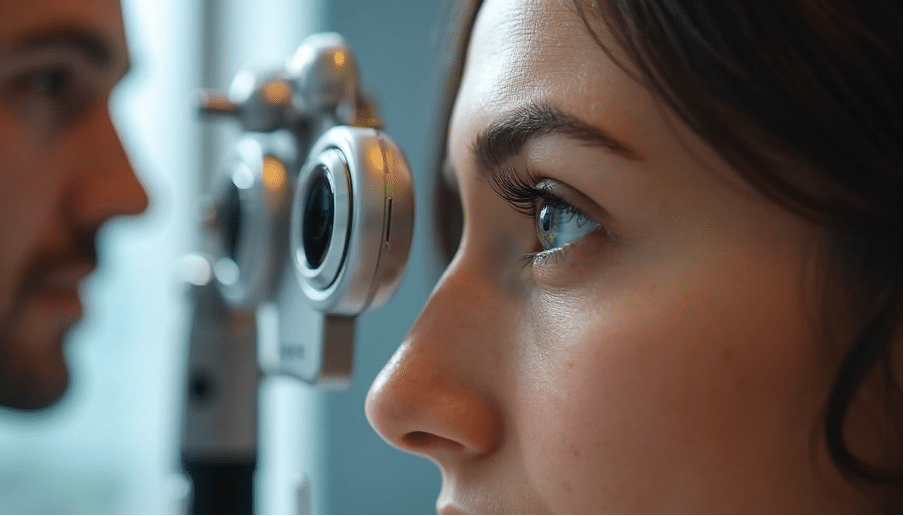British population statistics show hypermetropia affects 56% of people, which is twice as common as myopia at 27%. Long-sightedness happens when light rays focus behind the retina instead of directly on it. This usually occurs because the eye is too short or doesn’t have enough focusing power. People with this condition find it hard to see things up close. Your daily activities like reading, writing and computer work can be affected a lot if you don’t get it treated.
The good news is that modern correction methods work great for all levels of hypermetropia. This includes mild cases (≤ 2.00 D), moderate (2.00-4.00 D), and high (> 4.00 D). Precision Vision London’s expert ophthalmologists use state-of-the-art technology and personalised care. They provide complete correction options from Laser Eye surgery to advanced surgical procedures.
This piece will guide you through everything about hypermetropia correction. You’ll learn about the condition and the best treatment options to restore your clear vision.

What is Hypermetropia and How Does It Affect Vision?
Hypermetropia happens when your eye can’t focus light properly onto the retina. This makes nearby objects look blurry while distant objects stay clearer. The condition affects people of all ages. Most babies are born with some degree of hypermetropia.
Understanding refractive errors
Vision problems occur when your eye’s shape stops light from focusing correctly on your retina – the light-sensitive tissue at the back of your eye. These are the most common vision problems worldwide. Four main types exist: nearsightedness (myopia), farsightedness (hypermetropia), astigmatism, and presbyopia.
Light rays enter a normal eye through the cornea and lens. These parts focus the rays exactly onto the retina. The retina changes these light signals into nerve impulses that travel to the brain, which creates the images we see. A refractive error like hypermetropia disrupts this delicate process.
Refractive errors usually happen because of:
- Eyeball length (too long or too short)
- Problems with cornea shape
- Changes in the lens that affect focusing ability
Hyperopia vs hypermetropia
Hyperopia and hypermetropia mean the same thing – they’re just different names to describe farsightedness. Both terms describe a refractive error that makes close objects appear blurry while distant objects look clearer.
Myopia (nearsightedness) makes distant objects blurry but keeps near vision clear. Hypermetropia works differently. Your eyes strain as they work harder to focus on nearby objects. Severe cases can affect both near and distance vision in adults with high degrees of hypermetropia.
Hypermetropia runs in families and people are usually born with it. Research shows it appears more often in Native Americans, African Americans, and Pacific Islanders compared to other backgrounds.
How the eye focuses light
Think of your eye like a cinema projector showing a film. The projector needs its lens positioned perfectly to create a sharp image. Your eye’s cornea and lens work together the same way. They bend (refract) incoming light rays to focus them exactly on your retina. The cornea does most of the focusing work. It’s the clear, dome-shaped front part of your eye. The lens behind it makes smaller adjustments through accommodation – changing shape to focus images at different distances.
In hypermetropia, something goes wrong with these parts:
- The eyeball is too short from front to back
- The cornea is too flat or not curved enough
- The lens can’t become round enough to focus properly
Light rays end up focusing behind the retina instead of directly on it. This wrong focal point causes blurry vision, especially for close objects. People with hypermetropia struggle to switch focus quickly between near and far objects, like when they copy from a whiteboard. Your eyes must work constantly to see clearly with hypermetropia. This leads to eye strain, headaches, and visual discomfort, especially during long periods of close work.
Common Symptoms and Causes of Hypermetropia
Hypermetropia affects your daily activities in many ways. The uncomfortable symptoms become worse during close-up tasks. Your eyes constantly struggle to focus clearly, which creates unique challenges unlike other vision conditions.
Eye strain and blurred near vision
People with hypermetropia must focus constantly, even when looking at distant objects. Close-up work requires the most eye effort. This ongoing strain guides to:
- Headaches, especially after prolonged reading or computer use
- Eye fatigue and tired eyes
- Blurred vision, especially when you have near objects
- Stinging or aching eyes
- Difficulty concentrating
If you have mild hypermetropia, these symptoms might not show up until adulthood. Young eyes can typically make up for it through their natural focusing ability. Students notice symptoms most often during exam preparation and just need glasses for close work. Your eyes gradually lose this compensatory ability after age 30. This makes previously manageable hypermetropia more noticeable. You might find yourself holding reading materials farther away to see them clearly – a classic sign of uncorrected hypermetropia.
Genetic and anatomical factors
The eye’s structural variations cause hypermetropia. The biggest problems with anatomy include:
- Short eyeball length – Your eyeball being abnormally short from front to back is the most common cause. Each 1mm decrease in axial length results in approximately 3 diopters of hypermetropia.
- Flat cornea – A cornea without enough curvature fails to refract light properly. Each 1mm increase in corneal radius of curvature creates about 6 diopters of hypermetropia.
- Lens position abnormalities – The lens sometimes sits farther back in the eye than normal.
Genetic factors are the foundations of hypermetropia development. The condition runs in families, which suggests inherited components influence eye development, particularly eyeball length. Native Americans, African Americans, and Pacific Islanders experience hypermetropia more often than other ethnic groups.
Severe cases (≥ +5.00 diopters) often come with microphthalmia – abnormally small eyes with axial lengths under 21mm. Extreme hypermetropia (≥ +10.00 diopters) sometimes appears as part of genetic syndromes including Leber congenital amaurosis, Senior-Løken syndrome, and certain forms of retinal dystrophy.
Hypermetropia with astigmatism
Hypermetropia often occurs with astigmatism, which creates more complex visual challenges. Astigmatism happens when your cornea or lens has mismatched curves. This causes light to focus at multiple points instead of a single focal point.
These combined conditions can cause:
- Blurred vision at all distances
- Distorted vision
- Increased eye discomfort and fatigue
- Difficulty with night vision
- More frequent headaches
Hypermetropia with astigmatism in one eye can lead to amblyopia (lazy eye) if left undiagnosed. This prevents vision from developing properly. Our expert ophthalmologists at Precision Vision London employ advanced diagnostic technology to identify both conditions, even with subtle symptoms.
How Hypermetropia is Diagnosed
Hypermetropia diagnosis needs specialised testing beyond basic vision screenings. Precision Vision London’s ophthalmologists use detailed diagnostic approaches to detect even subtle degrees of farsightedness.
Comprehensive eye exams
A thorough eye examination starts the process of diagnosing hypermetropia. This painless process has:
- Visual acuity assessment – measures your vision at various distances
- Refraction assessment – determines if you have vision problems such as farsightedness, nearsightedness, astigmatism, or presbyopia
- Slit-lamp examination – assesses the structures of your eyes
Our specialists will ask you to look through different lenses while viewing eye charts. This helps identify which lens combination gives you the clearest vision. On top of that, we assess your eyes’ health by checking refractive errors and other conditions like glaucoma or cataracts.
Cycloplegic refraction explained
Cycloplegic refraction remains the gold standard to diagnose hypermetropia. This technique involves:
- Administering eye drops that temporarily paralyse the eye’s focusing muscles (ciliary muscles)
- Preventing accommodation that might mask the true degree of hypermetropia
- Allowing ophthalmologists to measure the complete refractive error
Your pupils enlarge from the drops, which lets our specialists see wider views inside your eyes. Cycloplegic refraction typically reveals more hyperopia than standard testing—a vital difference in determining the right correction. Cyclopentolate and tropicamide are the most commonly used cycloplegic agents that provide effective results with minimal discomfort.
Why early diagnosis matters
Quick identification of hypermetropia helps prevent serious complications:
- Prevents development of amblyopia (lazy eye)
- Helps avoid accommodative esotropia (inward eye turning)
- Improves academic performance and reduces learning difficulties
Our expert team at Precision Vision London will guide you to the right treatment if you struggle with farsightedness. Book your personalised consultation today to start your path toward sharper, stress-free vision. Regular eye examinations should start, with ongoing check-ups throughout life. Our specialists help ensure healthy visual development through early detection and appropriate correction to prevent long-term vision problems from untreated hypermetropia.
Non-Surgical Correction Options
People with hypermetropia can correct their vision effectively without surgery. Precision Vision London provides several proven solutions that match your specific needs.
Prescription glasses with convex lenses
Prescription glasses are the simplest way to correct hypermetropia. These glasses use convex lenses (plus lenses) with a thicker centre than edges. This design helps counter your cornea’s decreased curvature or shorter eyeball length.
The convex shape helps your vision by:
- Bending light rays inward to help them meet
- Moving incoming light to focus on the retina instead of behind it
- Creating a positive power that lets you see both near and far objects clearly
You might only need glasses to read or work up close if you have mild to moderate hypermetropia. People with more serious hypermetropia often benefit from wearing glasses all day.
Contact lenses: types and benefits
Contact lenses are a great alternative to glasses that sit right on your eye’s surface. They come with several advantages over regular glasses: Spherical contact lenses work best to correct hypermetropia. These lenses maintain the same power throughout their optical part and help eliminate the blur that comes with farsightedness.
You can choose between two main types:
- Soft contact lenses: These are flexible, comfortable and easy to get used to within days. You can get them as daily disposables or planned replacements
- Gas permeable (GP) lenses: These last longer and give sharper vision for certain prescriptions, but you might need more time to adjust to them
Toric lenses can fix both hypermetropia and astigmatism at once, which takes care of both issues together.
Orthokeratology (Ortho-K) for temporary correction
Orthokeratology is a chance to correct hypermetropia without surgery. This groundbreaking treatment lets you wear specially designed rigid gas-permeable contact lenses while you sleep. These lenses reshape your cornea temporarily. Hyperopic ortho-k works differently from myopia treatment. It makes the central cornea steeper to bring the focal point forward. The lenses create a central fluid reservoir that makes the central epithelium thicker while pressing down on the mid-peripheral tissue.
Your cornea keeps its new shape after you take out the lenses each morning. This gives you clear vision all day without glasses or contacts. Since the effects don’t last forever, you can always go back to your natural eye shape. Ortho-K works especially well when you have an active lifestyle and want to avoid wearing glasses during the day, but don’t want permanent surgical changes.
Surgical Treatments for Long-Term Correction
Looking for a permanent fix for hypermetropia? Surgical treatments are a great way to get long-term freedom from glasses and contact lenses through precise corneal reshaping or lens replacement procedures.
Laser eye surgery (LASIK, PRK, LASEK)
Laser vision correction treats mild to moderate hypermetropia by reshaping the cornea to properly focus light onto the retina. Precision Vision London provides three primary laser procedures:
LASIK (Laser-Assisted In Situ Keratomileusis) uses a femtosecond laser to create a thin flap in the cornea, then reshapes the underlying tissue with an excimer laser. This popular procedure gives you quick recovery—typically 24-48 hours with minimal discomfort. The surgery lasts about 15 minutes and patients feel no pain.
PRK (Photorefractive Keratectomy) or LASEK (Laser Epithelial Keratomileusis) might work better for patients with thin corneas. These surface laser treatments reshape the cornea without creating a flap. Recovery takes 1-2 weeks and vision improves gradually as the surface layer heals.
Lens replacement surgery and refractive lens exchange
Refractive lens exchange (RLE) replaces your eye’s natural lens with an artificial intraocular lens (IOL). This procedure, similar to modern cataract surgery, works especially well for:
- Hypermetropia exceeding +4.00 diopters
- Patients over 40 with early presbyopia
- Cases where laser surgery isn’t suitable
The surgery takes 15-30 minutes per eye and patients usually go home the same day. Most people achieve driving-standard vision or better, and 95% need fewer glasses after the procedure.
Choosing the right procedure based on age and eye health
Your age is a vital factor in selecting the most suitable surgical approach:
- Under 40: Laser vision correction works best for patients with good lens flexibility and healthy corneas.
- Over 40-50: RLE becomes the preferred choice as the natural lens loses flexibility and presbyopia develops.
Our expert team guides you through laser vision correction and lens-based solutions to find your ideal treatment. Book your personalised consultation at Precision Vision London today and start your journey toward clearer, worry-free vision.
Several factors shape which procedure will give you the best results. These include corneal thickness, prescription strength, overall eye health and lifestyle needs. Our specialists examine these factors to determine the safest, most effective approach for your specific visual needs.
Conclusion
Hypermetropia affects much of the British population. In spite of that, modern correction methods now give excellent solutions for every severity level. Your options play a key role to make informed decisions about your eye health. The right correction approach depends on your specific needs, lifestyle, and your farsightedness level.
Prescription glasses with convex lenses provide simple correction for many patients. Contact lenses are a great way to get more flexibility without losing visual clarity. Orthokeratology is another effective option, especially when you have an active lifestyle and want freedom from eyewear during the day.
Laser eye surgeries like LASIK, PRK, or LASEK can reshape your cornea to fix mild to moderate hypermetropia if you want permanent solutions. Without doubt, refractive lens exchange becomes the best choice for patients over 40 or those with higher degrees of farsightedness. This option gives freedom from both hypermetropia and developing presbyopia.
Your vision needs expert care from professionals who know the nuances of hypermetropia correction. Precision Vision London’s ophthalmologists combine advanced diagnostic technology with personalised treatment plans that match your unique visual needs. Detailed eye examinations help catch issues early and will give you the best visual outcomes.
Your trip to clear vision starts with booking a consultation. Our specialists will guide you through all available options to help you make the best choice for your long-term visual health. Note that hypermetropia correction improves your vision and your quality of life by removing eye strain, headaches, and visual fatigue that often come with this condition. Of course, with the right approach and expert guidance, you can look forward to clear, comfortable vision whatever your degree of hypermetropia.
Key Takeaways
Understanding hypermetropia correction empowers you to make informed decisions about your vision health and choose the most suitable treatment approach for your lifestyle.
- Hypermetropia affects 56% of Britons, causing blurred near vision and eye strain due to light focusing behind the retina rather than on it.
- Early diagnosis through comprehensive eye exams prevents complications like amblyopia.
- Non-surgical options include prescription glasses, contact lenses, and orthokeratology, offering effective correction without permanent procedures.
- Laser surgery (LASIK, PRK) suits patients under 40, whilst lens replacement works better for those over 40 with presbyopia.
- Professional assessment determines the safest, most effective correction method based on your age, prescription strength, and eye health.
The key to successful hypermetropia correction lies in choosing the right treatment at the right time. Whether you opt for glasses, contacts, or surgical intervention, expert guidance ensures optimal visual outcomes and long-term eye health.
FAQs
Q1. What are the most effective methods for correcting hypermetropia? The most effective methods for correcting hypermetropia include prescription glasses with convex lenses, contact lenses, and surgical options like laser eye surgery (LASIK, PRK) or lens replacement surgery. The best method depends on factors such as age, degree of hypermetropia, and overall eye health.
Q2. Can hypermetropia be corrected permanently? Yes, hypermetropia can be corrected permanently through surgical procedures. Laser eye surgery, such as LASIK, can reshape the cornea for mild to moderate cases. For higher degrees of hypermetropia or patients over 40, lens replacement surgery (refractive lens exchange) offers a long-term solution.
Q3. How does orthokeratology work for hypermetropia correction? Orthokeratology involves wearing specially designed rigid contact lenses overnight to temporarily reshape the cornea. For hypermetropia, these lenses steepen the central cornea, adjusting the focal point to improve vision during the day without the need for glasses or daytime contacts.
Q4. At what age should hypermetropia be diagnosed and treated? Early diagnosis of hypermetropia is crucial. It’s recommended to have eye examinations before starting school and regular check-ups throughout life. Early detection and treatment can prevent complications like amblyopia (lazy eye) and support proper visual development.
Q5. How do I choose between glasses and contact lenses for hypermetropia? The choice between glasses and contact lenses depends on personal preference, lifestyle, and the degree of hypermetropia. Glasses are straightforward and low-maintenance, while contact lenses offer more flexibility and a wider field of clear vision. Some people use both, wearing contacts for activities and glasses for rest periods.
Authors & Reviewer
-
 Olivia: Author
Olivia: AuthorHi, I'm Olivia, a passionate writer specialising in eye care, vision health, and the latest advancements in optometry. I strive to craft informative and engaging articles that help readers make informed decisions about their eye health. With a keen eye for detail and a commitment to delivering accurate, research-backed content, I aim to educate and inspire through every piece I write.
-
 Dr. CT Pillai: Reviewer
Dr. CT Pillai: ReviewerDr. CT Pillai is a globally recognised ophthalmologist with over 30 years of experience, specialising in refractive surgery and general ophthalmology. Renowned for performing over 50,000 successful laser procedures.

